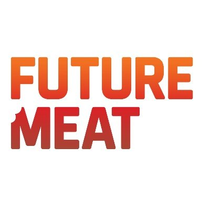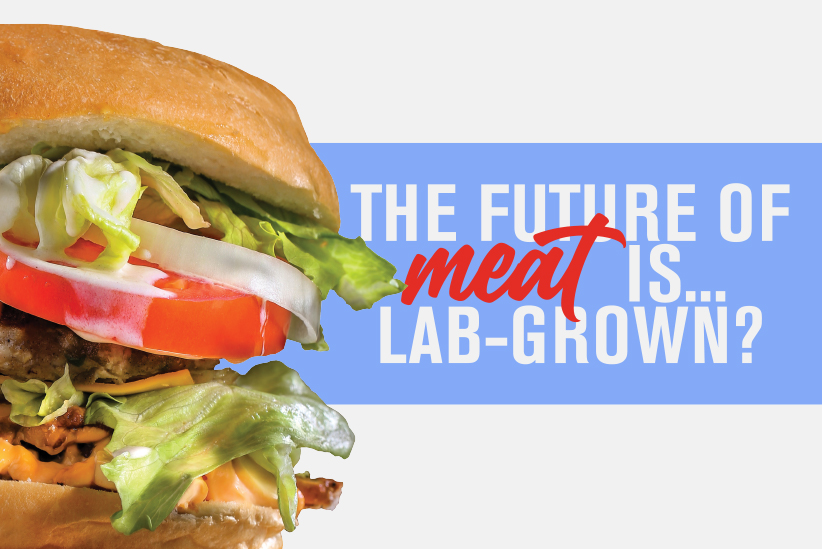Lab-grown meat (also known as clean meat, cultured meat, cellular agriculture, or in-vitro meat) is simply flesh that is grown outside of an animal’s body. The meat itself is real, but it is obtained without slaughter. Aiming to disrupt the conventional ways of producing animal products, the goal of lab-grown meat is to create more ethical and sustainable food, as well as reducing the number of animals killed for food.
Can you imagine enjoying a delicious hamburger made with cultured meat… which doesn’t involve the slaughter of animals? As of recently, cultured meat has been approved for sale, and this development is a big moment in the meat industry. If widely adopted, lab-grown meat has the potential to eliminate a large portion of the cruel and unethical treatment of animals that are raised for food.

It is created by taking the cells of an animal, and growing them from outside of the animal’s body. Although there are different ways that this process can be approached, every lab-grown meat product starts with a sample of tissue. Technicians then will collect the stem cells from the tissue sample, multiply them, and then allow them to differentiate into primitive fibres that will bulk up to form muscle tissue. One tissue sample from a cow can yield enough muscle tissue to make approximately 80,000 quarter-pounders!

They definitely don’t call it “clean meat” for nothing! Many of the worries one might have with regular meat, is a non-issue with lab-grown meat. For example, E. coli can be eliminated entirely in the laboratory and production facilities where the products will be produced… so there is no worry of fecal matter contaminating the meat.
Among many other positives, the use of antibiotics would also be eliminated, and fat and cholesterol levels in meat that is lab-grown can also be controlled… which would lead to potentially positive health outcomes. Lab-gown meat can also be fortified with vitamins and minerals to deliver even more nutrition, much like other products we consume today (like cereal, milk and bread).
We can’t forget the positive environmental impact, either. One of the biggest bonuses with lab-grown meat is the lack of land use, given that it would require 95% less of it. In theory, lab-grown meat production could free up millions of acres of land that is currently dedicated to livestock. Did you know that the global demand for meat is expected to increase by 73% between now and 2050? If conventional meat production remains as is, there will not be enough land left to meet the enormous demand. Lab-grown meat could also benefit emissions, with some estimates claiming there could be reductions between 74% and 87% in comparison to the emissions from cattle farms.

In December of 2020, California-based start-up by the name of Eat Just, received the green light to sell its chicken meat, making it the world’s first regulatory approved lab-grown meat in Singapore. An Israeli company by the name of Future Meat Technologies, and a California company named Wildtype, are also working to commercialize it’s products for sale in the United States.

Future Meat recently opened up the world’s first industrial cultured meat facility, which is capable of producing 1,100 pounds of lab-grown meat products per day (which is roughly equivalent to 3,000 regular-sized hamburgers). “After demonstrating that cultured meat can reach cost parity faster than the market anticipated, this production facility is the real game-changer,” chief scientific officer of Future Meat, Yaakov Nahmias, said. Then, in April 2021, lab-grown meat became available for home delivery for the first time thanks to a partnership between Eat Just and Foodpanda, a delivery platform.

Customers are now able to order three dishes made with GOOD Meat chicken (the brand under which Eat Just is creating its lab-grown meat) from the Singapore-based restaurant 1880. These three dishes include: Chicken and Rice with coconut rice, pak choi, sweet chili, chrysanthemums, and microgreens; Katsu Chicken Curry with jasmine rice, heritage carrots, micro shiso, and edible flowers; and Chicken Caesar Salad with kale, romaine, edible flowers, shaved radish, and plant-based Caesar dressing. This is currently the only way to try lab-grown meat, as it isn’t available for wide consumption yet.

Lab-grown meat is an animal product, unlike plant-based meat products that are made from plant materials like mushroom, beans and tofu… therefore, it is not considered a vegan or vegetarian food. Lab-grown meat requires cells that have been biopsied from living animals, and because the process involves taking cells from living animals that cannot give their consent, these products may not be suitable for everyone. For those who are vegetarian due to concern about the environmental impact of the meat industry, lab-grown meat may be very appealing.

In order to claim that lab-grown meat is better for the environment than real meat, companies that are working to grow meat from animal cells must need to avoid fossil fuels and minimize energy used. Lab-grown meat that has high-energy inputs could potentially spur global warming more in the long term than some types of cattle farming. On top of this, the production of lab-grown meat is very expensive. When it becomes available for wide consumption, it will be quite a bit pricier than conventional meat for a while.
For the moment, the idea of lab-grown meat is pretty bogged down in regulatory disagreements between the FDA and USDA. If we’re looking at the long term, the widescale production of lab-grown meat would need cost and resource-effective energy infrastructures to be feasible. Due to the fact that lab-grown meat is not yet determined to be better or worse than conventional meat, it’s not an automatic win yet… but it certainly has some great potential.




